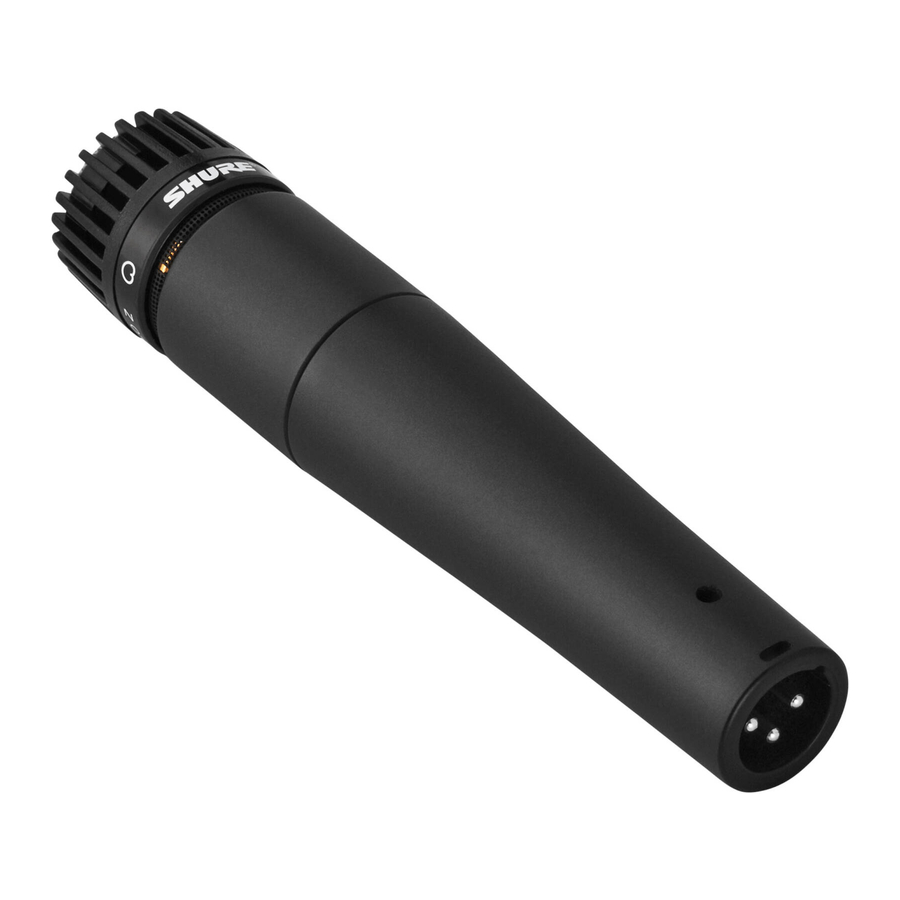
Shure SM57 - Microphone Manual
- User manual (26 pages) ,
- Product manual (16 pages) ,
- Manual (32 pages)
Advertisement

UNIDIRECTIONAL DYNAMIC MICROPHONE
The Shure SM57 unidirectional dynamic microphone is exceptional for musical instrument pickup or for vocals. With its bright, clean sound and carefully contoured presence rise, the SM57 is ideal for live sound reinforcement and recording. It has an extremely effective cardioid pickup pattern which isolates the main sound source while minimizing background noise. In the studio, it is excellent for recording drums, guitar, and woodwinds. For musical instruments or vocals, the SM57 is a consistent choice of professional performers.
Features
- Frequency response tailored for drums, guitars, and vocals
- Uniform cardioid pickup pattern isolates the main sound source while reducing background noise
- Pneumatic shock-mount system cuts down handling noise
- Extremely durable under the heaviest use
- Supplied break-resistant swivel adapter that rotates 180 °
- Legendary Shure quality, ruggedness, and reliability
STAGE MONITOR & P.A. LOUDSPEAKER PLACEMENT
Place the stage monitor directly behind the microphone (see Figure 1). Locate the P.A. loudspeakers so that they point away from the rear of the microphone. With the speakers located in these positions, the possibility of feedback is greatly reduced. Always check the stage setup before a performance to ensure optimum placement.

RECOMMENDED LOUDSPEAKER PLACEMENT
FIGURE 1
APPLICATION AND PLACEMENT
Some of the most common applications and placement techniques for the SM57 are listed in the following table. Remember that microphone technique is largely a matter of personal taste— there is no single "correct" microphone position.
| APPLICATION | SUGGESTED MICROPHONE PLACEMENT | TONE QUALITY |
| Tom-Toms | One SM57 on each tom, or between each pair of toms, 25 mm (1 in.) to 75 mm (3 in.) above the heads. Aim each mic at the top heads. | Medium attack, balanced sound. |
| On double head toms, remove the bottom head and place a mic inside aimed at the head. | Medium attack, balanced sound. | |
| Snare Drum | 25 mm (1 in.) to 75 mm (3 in.) above the rim of the top head of the drum. Aim the mic at the head. | Most "snap" from drumstick impact |
| If desired, place a second mic just below the rim of the bottom head. | More "snare" sound. | |
| Guitar & Bass Amplifiers | 25 mm (1 in.) from the speaker, on-axis with the speaker cone. | Most attack, emphasized bass |
| 150 mm (6 in.) to 300 mm (12 in.) away from speaker and on-axis with speaker cone. | Medium attack, full, balanced sound | |
| .5 m (18 in.) to 1 m (3 ft) back from the speaker, on-axis with the speaker cone. | Softer attack, thin, reduced bass sound. | |
| On-axis with the edge of the speaker cone. | Thinner, reduced bass sound. | |
| Brass & Woodwinds | Brass: .3 m (1 ft) to 1 m (3 ft) away, on-axis with bell of instrument. | Bright, clear sound. |
| Woodwinds: 25 mm (1 in.) to 150 mm (6 in.) away, on-axis with bell of instrument. | Bright, clear sound. | |
| Bell of the instrument 90° offaxis from the front of the mic. | Softer, mellow sound. | |
| Vocals & Speech | 25 mm (1 in.) to 150 mm (6 in.) from the vocalist's mouth. | Rich, warm sound. |
PROXIMITY EFFECT
When the sound source is less than 6 mm (1/4 in.) from the microphone, the microphone boosts bass frequencies (by 6 to 10 dB at 100 Hz), creating a warmer and richer bass sound than when farther away. This effect, known as proximity effect, happens in unidirectional microphones like the SM57. The SM57 low-frequency roll-off provides greater control, allowing the user to take full advantage of proximity effect.
GENERAL RULES FOR MICROPHONE USE
- Aim the microphone toward the desired sound source andaway from unwanted sources.
- Locate the microphone as close as practical to the desiredsound source.
- Work close to the microphone for extra bass response.
- Use only one microphone per sound source.
- Locate multiple microphones at least three times as far fromother microphones as from the sound source.
- Use as few microphones as practical.
- Place microphones away from sound reflecting surfaces.
- Add a windscreen when using the microphone outdoors, forcloseup speech, or vocals.
- Avoid excessive handling to minimize mechanical noise.
SPECIFICATIONS
Type
Dynamic
Frequency Response
40 to 15,000 Hz (see Figure 2)

Polar Pattern
Unidirectional (cardioid), rotationally symmetrical about microphone axis, uniform with frequency (see Figure 3)

TYPICAL POLAR PATTERNS
FIGURE 3
Sensitivity (at 1,000 Hz)
Open Circuit Voltage: –54.5 dBV/Pa* (1.9 mV)
*(1 Pa = 94 dB SPL)
Impedance
Rated impedance is 150Ω (310Ω actual) for connection to microphone inputs rated low impedance.
Polarity
Positive pressure on diaphragm produces positive voltage on pin 2 with respect to pin 3 (see Figure 4).

INTERNAL CONNECTIONS
FIGURE 4
Connector
Three-pin professional audio connector (male XLR type)
Case
Dark gray, enamel-painted, die-cast steel with a polycarbonate grille and a stainless steel screen.

DIMENSIONS
FIGURE 5
Swivel Adapter
Positive-action, break-resistant, adjustable through 180°, with standard 5/8 in.-27 thread
Net Weight (without cable)
284 grams (10 oz)
FURNISHED ACCESSORIES
Swivel Adapter - A25D
Storage Bag - 26A13
OPTIONAL ACCESSORIES
Windscreen - A2WS
Desk Stand - S37A, S39A
Isolation Mount - A55M
Dual Mount - A25M, A26M
Cable (7.6 m [25 ft]) - C25E, C25F
REPLACEMENT PARTS
Cartridge - R57
Screen and Grille Assembly - RPM210
For additional service or parts information, please contact Shure's Service department at 1-800-516-2525. Outside the United States, please contact your authorized Shure Service Center.
Documents / ResourcesDownload manual
Here you can download full pdf version of manual, it may contain additional safety instructions, warranty information, FCC rules, etc.
Advertisement


















Need help?
Do you have a question about the SM57 and is the answer not in the manual?
Questions and answers